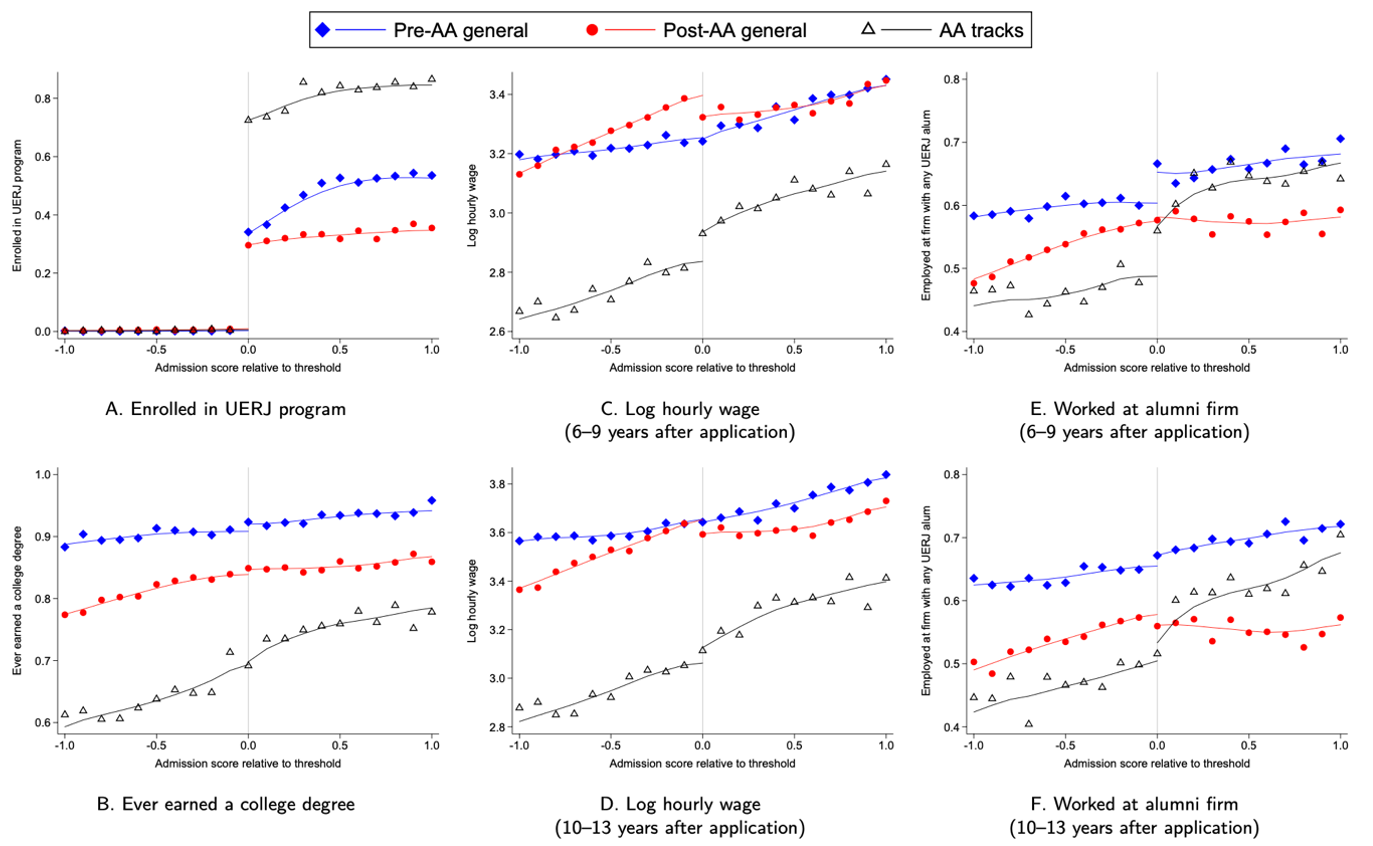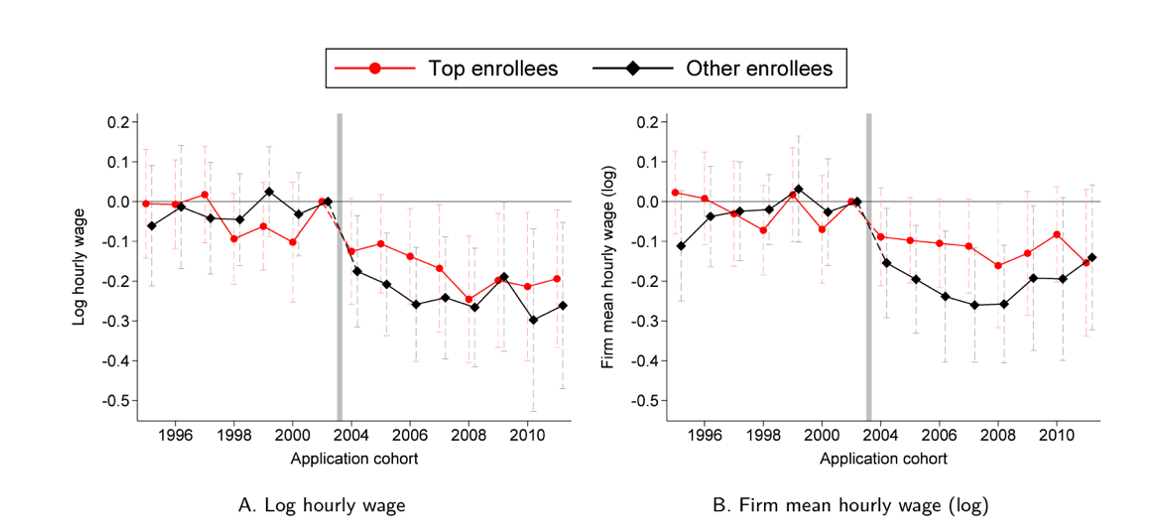
Evidence from an elite university in Brazil that began reserving 45% of its admission slots for low-income and minority applicants shows that the policy increased early-career earnings for disadvantaged students, yet it also reduced the earnings of their higher-scoring peers.
Higher education is often viewed as an engine of social mobility. However, individuals from low-income families are often underrepresented in selective universities, which can lead to higher inequality in labour market outcomes after college (Chetty et al. 2020). Affirmative action policies aim to reduce this inequality by increasing the representation of low-income and minority students in selective universities (Arcidiacono et al. 2015, Oliveira et al. 2024).
Previous research has found that affirmative action works at moderately selective universities. At these institutions, affirmative action allows disadvantaged students to attend colleges with greater resources and higher graduation rates. This increases the likelihood that they earn a college degree, which improves their labour market prospects (Bleemer 2022). However, the impacts of affirmative action may differ at elite institutions. All admitted students to these universities are highly qualified, so those displaced by affirmative action are likely to earn a degree from another selective school. So, what role do large-scale affirmative action policies play at elite universities?
Institutional context: The affirmative action policy at an elite university in Brazil
Our research (Machado, Reyes, and Riehl 2024) sheds new light on this question by examining the academic and career impacts of a major affirmative action policy at one of Brazil's most prestigious public universities, the Rio de Janeiro State University (UERJ). In the early 2000s, UERJ began reserving 45% of its admission slots for low-income and minority applicants, which dramatically increased the racial and socioeconomic diversity of its student body.
We combined applications and enrollment data with earnings records to analyse the academic and early-career trajectories of all UERJ students, focusing on the policy's impact on two distinct groups: 1) the “targeted” students who were directly admitted through the affirmative action program, and 2) the “non-targeted” students who would have gained admission regardless of the policy.
The benefits for targeted students: Increased earnings and access to high-paying firms
Using a regression discontinuity design, we find that the affirmative action policy had positive impacts on its targeted beneficiaries. Specifically, marginally admitted affirmative action students experienced a 14% boost in early-career earnings from enrolling in UERJ (Figure 1, Panel C). Notably, this gain was driven not by increased college degree attainment (Figure 1, Panel B), but rather by greater access to high-paying firms affiliated with its alumni network (Figure 1, Panel E). This finding suggests that a key benefit of enrolling in an elite university for disadvantaged students is gaining access to valuable job networks.
However, these earnings and networking benefits faded as affirmative action enrollees progressed in their careers. The estimated earnings returns declined over time and were smaller for later cohorts (Figure 1, Panel D). This pattern suggests that while elite university admission can help disadvantaged students gain a foothold in the labour market, they may face additional barriers to career advancement not fully overcome by an initial leg up.
Figure 1: Regression discontinuity graphs showing the impacts of affirmative action on UERJ enrollment, earnings, and employment at alumni firms

Notes: This figure shows regression discontinuity graphs for pre-affirmative action general applicants (blue diamonds), post-affirmative action general applicants (red circles), and affirmative action applicants (black triangles).
The spillover effects of affirmative action on non-targeted students: Lower earnings
Using a differences-in-differences design comparing college majors with more- and less-exposure to the affirmative action policy, we find that the policy had negative spillover effects on “top enrollees” — students with a test score high enough to be admitted regardless of the existence of the policy. These highly ranked students experienced a decrease in their early-career earnings that persisted up to 13 years after college application (Figure 2).
Figure 2: Event study estimates for individual and firm mean hourly wages 6–9 years applying to UERJ

Notes: This figure plots coefficients from an event study. The dependent variables are measured 6–9 years after application. Red markers show estimates for top enrollees. Blue markers show estimates for other enrollees. The vertical grey line indicates when the affirmative policy was introduced.
We explore three potential mechanisms for the earnings decline of top enrollees: compositional changes, peer networks, and human capital accumulation. We find limited evidence of changes in characteristics of top enrollees, such as age, gender, or exam scores, suggesting this does not play a major role in explaining the earnings decline.
Instead, these negative spillovers appear to have been driven by two main mechanisms:
- Reduced value of peer networking: Top students in majors with larger affirmative action enrollments became less likely to gain jobs at high-paying firms affiliated with its alumni network.
- Learning impacts: Top students in highly exposed majors performed worse on a national exit exam, suggesting they accumulated less human capital during college possibly due to changes in course material in response to affirmative action.
Conclusions: Balancing upward mobility and institutional value
Our findings illustrate that elite universities face a tradeoff between expanding access for disadvantaged students and maintaining the value their of their degrees that stems from selective admissions. UERJ's large-scale affirmative action policy successfully increased upward mobility for disadvantaged students, but at the cost of reducing top students' learning, networking value, and long-run earnings. To maintain the value of their degrees while still promoting access for disadvantaged students, universities could consider implementing affirmative action gradually. Another approach is to identify enrollees who may be less academically prepared and provide targeted resources to help them be as prepared as their classmates from advantaged backgrounds.
While our research does not speak to non-pecuniary benefits of campus diversity, it underscores that the impacts of large-scale affirmative action at elite universities can be very different than at less selective institutions where prior research has focused. As debates over these policies continue worldwide, it will be crucial to tailor them to each university's context and evaluate their full range of direct and spillover effects.
References
Arcidiacono, P, M Lovenheim, and M Zhu (2015), “Affirmative action in undergraduate education”, Annual Review of Economics, 7(1): 487-518.
Bleemer, Z (2022), “Affirmative action, mismatch, and economic mobility after California’s Proposition 209”, Quarterly Journal of Economics, 137(1): 115-160.
Chetty, R, J N Friedman, E Saez, N Turner, and D Yagan (2020), “Income segregation and intergenerational mobility across colleges in the United States”, Quarterly Journal of Economics, 135(3): 1567-1633.
Machado, C, G Reyes, and E Riehl (forthcoming), “The Direct and Spillover Effects of Large-scale Affirmative Action at an Elite Brazilian University”, Journal of Labor Economics.
Oliveira, R, A Santos, and E Severnini (2024), “Affirmative action in Brazil’s higher education system”, VoxDev. https://voxdev.org/topic/education/affirmative-action-brazils-higher-education-system



